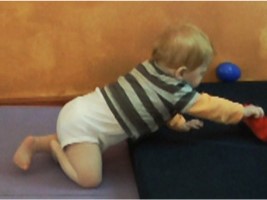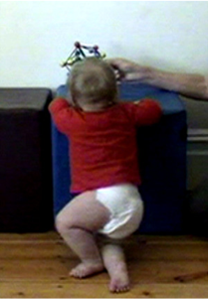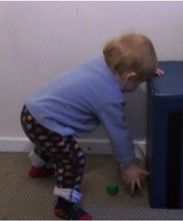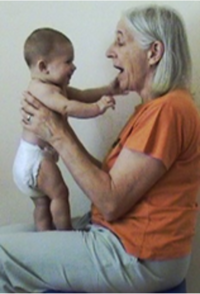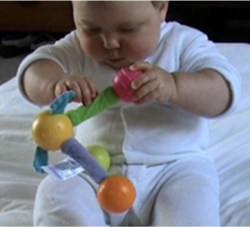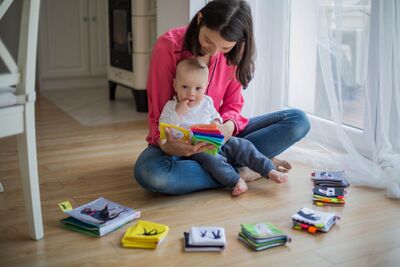Best Practice in Developmental Skills Training in Early Intervention
Original Editor - Robin Tacchetti
Top Contributors - Robin Tacchetti, Robin Leigh Tacchetti, Tarina van der Stockt, Kim Jackson, Ewa Jaraczewska, Naomi O'Reilly, Jess Bell and Olajumoke Ogunleye
Early Intervention[edit | edit source]
Early intervention is a United States federal program that provides education and therapeutic resources to families of children with developmental delays 3 and under. Services covered in early intervention can include speech, OT, PT, vision, nursing, hearing and assistive technology. Evaluations are performed in a natural environment for the child such as the home or daycare. [1]Watch the video below from the Allen County Board of Developmental Disabilities to get a quick understanding of early intervention.
Family Centred Care[edit | edit source]
Early intervention services are geared toward empowering families to be the decision-makers for their child’s goals and intervention. In this family centred approach, the therapist works as a coach and collaborator with the family and not one of expert knowledge who makes all the decisions.[1] Initially, the therapist will discuss the family’s comfort and any difficulties they may be experiencing. Understanding their concerns and hopes will help shape goals and specific intervention tasks. During the assessment, the therapist will observe the child performing specific tasks to determine what they are capable of, their strengths, how much assistance is required, what is inhibiting the task and what adaptations can be made. The therapist and family then collaborate by discussing ways to practice the tasks within the child’s daily routine. Providing home exercise programs via video or written instruction are helpful reminders for families. [2]
GOALS[edit | edit source]
Dalmau et al,[3]( recommended the following components are necessary when setting up goals for the child:
1. "They are functional and needed for the child and family to be able to participate in the activities that are important for them. The goals are always established on the basis of what the family considers to be necessary and functional for them, not on the basis of what the professional thinks or believes to be useful or significant in their lives
2. They reflect real situations of daily life and routines of the families, such as having meals, baths, going to the park, etc. Often, the goals set up by developmental areas are neither contextualized nor represent situations of daily life.
3. They describe the participation of the child and/or family in routines, which means that in the writing it is the child or family that are the “actors”, not the professionals.
4. Their writing has to be free of jargon, using daily routines and activities.
5. They always emphasize positive actions, identifying what the child or family can do, rather than what they cannot do.
6. Active voice is preferred to passive voice; expressions that imply involvement and active participation of the child/family"
GAME INTERVENTION[edit | edit source]
One early intervention strategy used for infants at risk for CP is called GAME: goal (G) based activity (A) with intensive motor training (M) in an enriched environment (E). [4] This intervention is comprised of three factors:
- Goal-oriented intensive motor training
- Parent education
- Strategies to enrich the child’s motor learning environment
Weekly visits are typical initially with frequency moving to the family’s preference, availability and resources. A session of GAME intervention usually lasts between 60-90 min. [2] A recent systematic literature review showed GAME intervention prior to 5 months old to be superior to standard intense care.[5]
Goal Oriented[edit | edit source]
Goals created by the therapist and family will be the focus during practice sessions and for the home program. The task goal materializes based on the interplay of the task requirement (task demand) (T), the individual child (I) and the environment (E) or TIE principle. When analyzing the child’s performance, all three components of the TIE principle must be analyzed. [6] Task-specific training should incorporate successful trials as it motivates the child towards continued repetition. Optimal outcomes are seen through repetition and intensity. [7] Goals and tasks may be adapted to achieve success with the whole or parts of the task. Once they are successful in a specified task, the motor skill is challenged building on the previously learned skill. Activities accentuate minimal manual guidance with the ability to withdraw assistance once the child is able to successfully demonstrate the specified movement or sequence.[2]
Early Weightbearing[edit | edit source]
Early weight bearing and sit to stand from the parents’ lap is a routine GAME intervention even if they are not specified goals. Research shows that functional weight-bearing can provide strength training and improve motor control in older children and adults with brain injuries. Upright mobility can be enhanced by the early activation of muscles in the leg with the facilitation of concentric and eccentric exercises. For children with CP, routine standing practice could assist with impairments such as weakness and selective motor control.[2]
REACHING AND GRASPING[edit | edit source]
For infants who are anticipated to have a delay, grasping and reaching a variety of objects are standard tasks of motor training within GAME intervention. Providing opportunities to use hands through experience is critical to optimizing hand function.[2] In cases where asymmetrical hand function is present, modified constraint induced movement therapy and/or bimanual training can be used.[5][7] Research shows infants with unilateral CP who performed CMIT during their first year of life had a positive influence on their hand function.[8]
HOME PRACTICE[edit | edit source]
GAME intervention emphasizes the importance in developing a home program that allows the infant for independent play and play activities with the family. Written instructions with pictures are provided that relate to the families goals, as well as weight-bearing and reach and grasp activities. Home programs can be updated as goals are reached.[2]
PARENTAL EDUCATION[edit | edit source]
In GAME intervention, the therapist acts as a coach enhancing the parents knowledge of their child’s development and how best to enhance it.[7] Therapists educate families on:
- Analyzing simple motor tasks
- How to advance skills
- Use of “awake” time
- How to create repetition
- Setting opportunities for independent play
Parents are encouraged to provoke motor behaviors from the baby after observing the therapist demonstration. Coaching is done in a positive and warm context.[7]
ENVIRONMENTAL ENRICHMENT[edit | edit source]
An enriched motor play environment within the family’s home is the third aspect of GAME intervention. An enriched environment allows for exploration, task success and self-generated movements. Toys or equipment are used that the family already owns with a careful selection of what is needed to match the desired motor task.[2] Morgan et al,[2] stated that the whole environment is taken in account which may include:
- "evidence-based early learning stimulation and role modelling to enhance cognitive and language development (e.g. reading books to children, limiting passive television watching);
- optimising sleep hygiene;
- feeding interventions (e.g. anti-reflux medications) to ensure adequate caloric nutrition and pain-free backdrops for learning."
Extended family members are encouraged to engage in social interaction with the child as well as to participate in therapy sessions as it will help promote family knowledge, acceptance and wellbeing. GAME therapists visit weekly initially and then alter frequency based on the family’s availability, resources and preference.[2]
Resources[edit | edit source]
- Cerebral Palsy Introduction
- Family Centred Intervention and Early Diagnosis
- Gross Motor Function Classification System - Expanded and Revised (GMFCS-ER)
- Early Intervention in Cerebral Palsy
References[edit | edit source]
- ↑ 1.0 1.1 Tomasello NM, Manning AR, Dulmus CN. Family-centered early intervention for infants and toddlers with disabilities. Journal of Family Social Work. 2010 Mar 24;13(2):163-72.
- ↑ 2.0 2.1 2.2 2.3 2.4 2.5 2.6 2.7 2.8 Morgan C, Novak I, Dale RC, Guzzetta A, Badawi N. GAME (Goals-Activity-Motor Enrichment): protocol of a single blind randomised controlled trial of motor training, parent education and environmental enrichment for infants at high risk of cerebral palsy. BMC neurology. 2014 Dec;14(1):1-9.
- ↑ Dalmau M, Balcells-Balcells A, Giné C, Cañadas M, Casas O, Salat Y, Farré V, Calaf N. How to implement the family-centered model in early intervention. Anales de psicología. 2017;33(3):641-51.
- ↑ Gmmash AS, Effgen SK. Early intervention therapy services for infants with or at risk for cerebral palsy. Pediatric Physical Therapy. 2019 Jul 1;31(3):242-9.
- ↑ 5.0 5.1 Damiano DL, Longo E. Early intervention evidence for infants with or at risk for cerebral palsy: an overview of systematic reviews. Developmental Medicine & Child Neurology. 2021 Apr 6.
- ↑ Versfeld, P. Best Practice In Developmental Skills Training in Early Intervention. Course. Physioplus. 2021
- ↑ 7.0 7.1 7.2 7.3 Morgan C, Fetters L, Adde L, Badawi N, Bancale A, Boyd RN, Chorna O, Cioni G, Damiano DL, Darrah J, de Vries LS. Early Intervention for Children Aged 0 to 2 Years With or at High Risk of Cerebral Palsy: International Clinical Practice Guideline Based on Systematic Reviews. JAMA pediatrics. 2021 May 17.
- ↑ Eliasson AC, Nordstrand L, Ek L, Lennartsson F, Sjöstrand L, Tedroff K, Krumlinde-Sundholm L. The effectiveness of Baby-CIMT in infants younger than 12 months with clinical signs of unilateral-cerebral palsy; an explorative study with randomized design. Research in developmental disabilities. 2018 Jan 1;72:191-201.
